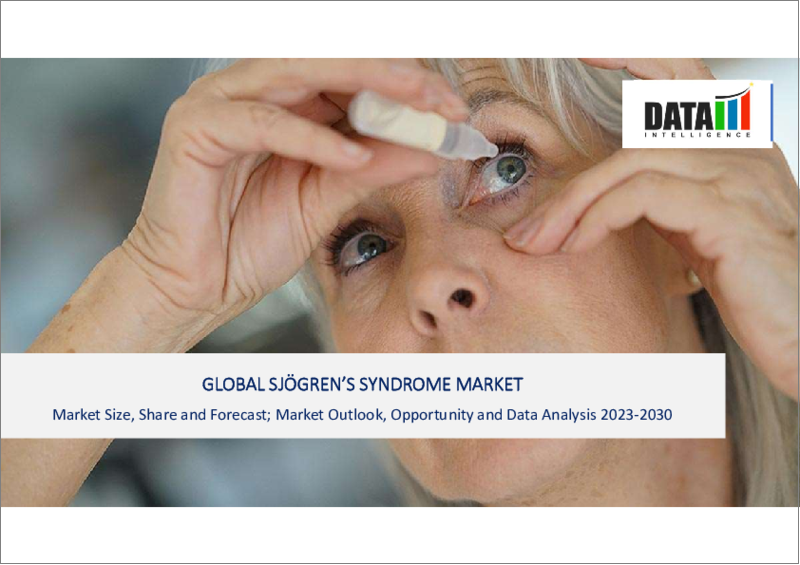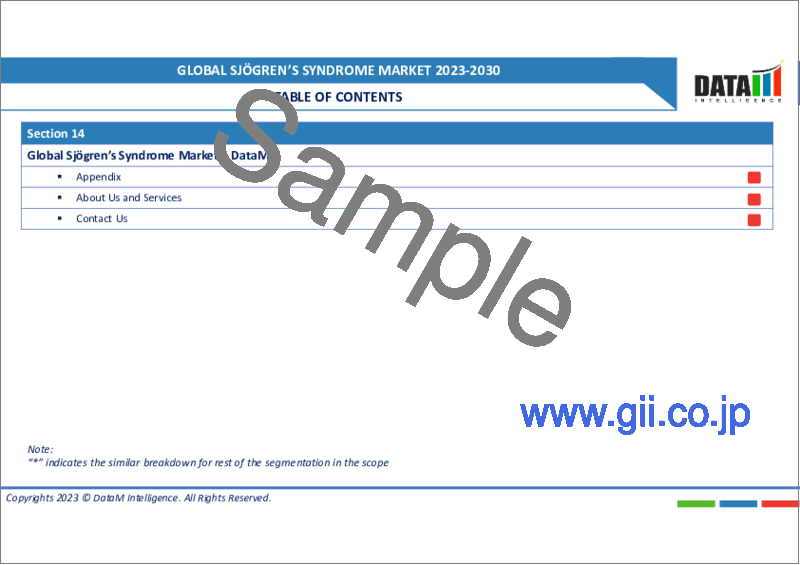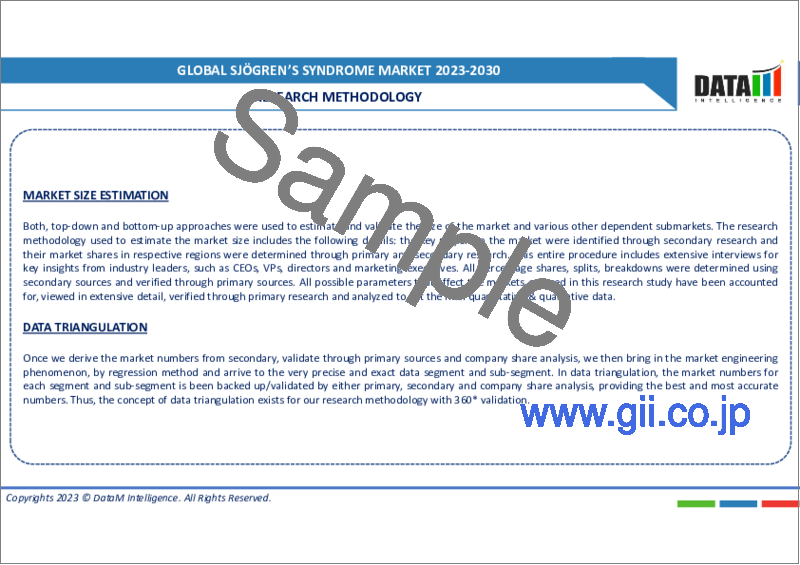|
|
市場調査レポート
商品コード
1179875
シェーグレン症候群の世界市場-2023-2030Global Sjogren's Syndrome Market - 2023-2030 |
||||||
|
● お客様のご希望に応じて、既存データの加工や未掲載情報(例:国別セグメント)の追加などの対応が可能です。 詳細はお問い合わせください。 |
|||||||
| シェーグレン症候群の世界市場-2023-2030 |
|
出版日: 2023年01月05日
発行: DataM Intelligence
ページ情報: 英文 200 Pages
納期: 約2営業日
|
- 全表示
- 概要
- 目次
市場概要
シェーグレン症候群の市場規模は、予測期間(2023~2030年)にCAGR4.2%で成長するとされています。
免疫系の病気であるシェーグレン症候群(SS)の代表的な症状は、目の乾きと口の渇きです。この症候群は、狼瘡や関節リウマチなど他の免疫系疾患と併存することが多いです。シェーグレン症候群では、まず口や目の粘膜や水分分泌腺が冒され、唾液や涙の分泌が少なくなります。女性の場合は、この病気がはるかに多くみられます。治療の目標は、症状を軽くすることです。
市場力学
シェーグレン症候群の世界市場を牽引する主な要因は、シェーグレン症候群やその他の自己免疫疾患が一般化していること、認知度の向上、最先端医療の必要性、さらに強力な医薬品パイプラインが市場の拡大に寄与していることです。
シェーグレン症候群やその他の自己免疫疾患は一般的になりつつあり、市場の成長を牽引すると予想されます。
シェーグレン症候群(SS)の主な症状は、口と目の渇きです。この病気はどの年齢でも起こり得ますが、多くの場合、中年期から徐々に悪化し始めます。シェーグレン症候群は、自己免疫疾患と呼ばれる病気の一つで、免疫系が自分の体の組織や臓器を攻撃することによって起こる病気です。シェーグレン症候群では、免疫系が主に唾液腺と涙腺を標的とし、涙と唾液を分泌する能力を制限します。シェーグレン症候群の発症率は、関節リウマチ(RA)の半分近く、つまり人口の0.5%から1.0%が罹患するとされています。
国立生物工学情報センター2022年。シェーグレン症候群は、40万人から310万人の成人が罹患すると言われています。この病気は年齢に関係なく発症しますが、平均的な発症年齢は45~55歳です。関節リウマチやループスなどの結合組織の病気も、患者さんの約半数に認められます。
シェーグレンは世界中で成人や小児の記録は少なく、発症率に人種や地理的な偏りはないようです。しかし、この疾患は明らかに女性に好発し、SLEと同様に女性:男性の比率は約9:1です。この疾患は一般的に中年期に発症しますが、幼児や高齢者にも発症する可能性があります。
シェーグレン症候群治療薬の入手に関する知識の不足が、市場成長の妨げになると予想されます。
しかし、治療費の高さや、急性脱水症、急激な体重減少、炎症などのシェーグレン症候群の影響により、市場の拡大が抑制されるでしょう。前述の予測期間中、シェーグレン症候群市場は、この疾患やその予防策、薬剤の副作用に関する知識の不足による課題に直面すると思われます。
COVID-19の影響分析
パンダイスの間、ほとんどの産業は負の反響を経験しました。これは、国際的な規制機関によって課された様々な予防的ロックダウンやその他の制限の結果、それらの製造およびサプライチェーンに大きな混乱が生じたことに起因しています。市場も同様です。大多数の人々の一般的な経済状態はパンダイスによって深刻な打撃を受け、その結果、人々は必要でない支出を予算から排除する傾向が強まり、消費者需要も低下しています。当四半期においては、このような要因が市場に悪影響を及ぼすことが予想されます。
また、重要な原材料へのアクセスを確保するために、多様なサプライチェーンの強靭性を高めることに再び関心が集まっています。新しいCOVID-19ワクチンや治療法の承認が急務となっているため、規制当局は評価と承認のプロセスを簡素化しています。このような進歩により、将来の医薬品の臨床的・商業的成功が増加することが期待されています。しかし、世界のシェーグレン症候群の業界は、当局の医薬品規制が解除されれば、回復に向かうと予想されています。
目次
第1章 調査手法と調査範囲
- 調査手法
- 調査目的および調査範囲
第2章 市場の定義と概要
第3章 エグゼクティブサマリー
第4章 市場力学
- 市場影響要因
- 促進要因
- シェーグレン症候群をはじめとする自己免疫疾患は、より一般的になりつつある
- 認知度の向上と最先端医療へのニーズの高まり
- 抑制要因
- シェーグレン症候群治療薬の入手に関する知識不足
- ビジネスチャンス
- 影響分析
- 促進要因
第5章 産業分析
- ポーターのファイブフォース分析
- サプライチェーン分析
- プライシング分析
- 規制分析
第6章 COVID-19の分析
- COVID-19の市場分析
- COVID-19以前の市場シナリオ
- COVID-19の現在の市場シナリオ
- COVID-19の後、または将来のシナリオ
- COVID-19の中での価格ダイナミクス
- 需要-供給スペクトラム
- パンデミック時の市場に関連する政府の取り組み
- メーカーの戦略的取り組み
- まとめ
第7章 薬物クラス別
- コリン作動性作動薬
- 適応外薬
第8章 症状別
- 目の乾き
- 口の渇き
第9章 タイプ別
- 原発性シェーグレン症候群
- 二次性シェーグレン症候群
第10章 販売チャネル別
- 病院
- 小売店
- オンライン薬局
第11章 地域別
- 北米
- 米国
- カナダ
- メキシコ
- 欧州
- ドイツ
- 英国
- フランス
- イタリア
- スペイン
- その他欧州
- 南米
- ブラジル
- アルゼンチン
- その他の南米地域
- アジア太平洋地域
- 中国
- インド
- 日本
- オーストラリア
- その他アジア太平洋地域
- 中東・アフリカ地域
第12章 競合情勢
- 主な展開と戦略
- 企業シェア分析
- 製品ベンチマーク
- 注目の主要企業リスト
第13章 企業プロファイル
- Novartis AG
- 企業概要
- 製品ポートフォリオと説明
- 主なハイライト
- 財務概要
- Allergan Inc
- Otsuka Pharmaceutical Co., Ltd
- Santen Pharmaceutical Co., Ltd.
- Nicox S.A
- Argentis Pharmaceuticals, LLC
- Auven Therapeutics
- Abbvie Inc
- Cellzome GmbH.
- Biogen In.
第14章 シェーグレン症候群の世界市場-DataM
Market Overview
Sjogren's Syndrome Market size was valued at US$ XX million in 2023 and is estimated to reach US$ XX million by 2030, growing at a CAGR of 4.2% during the forecast period (2023-2030).
The two most typical symptoms of Sjogren's syndrome (SS), an immune system illness, are dry eyes and a dry mouth. The syndrome frequently coexists with other immune system diseases like lupus and rheumatoid arthritis. The mucosal membranes and moisture-secreting glands of the mouth and eyes are typically impacted first in Sjogren's syndrome, which causes less saliva and tears to be produced. In women, the illness is far more prevalent. The goal of treatment is to diminish symptoms.
Market Dynamics
The major factors driving the global sjogren's syndrome market are that Sjogren's syndrome and other autoimmune illnesses are becoming more common, increasing awareness and the need for cutting-edge medical care, additionally, a strong drug pipeline has contributed to the market's expansion
Sjogren's syndrome and other autoimmune illnesses are becoming more common and are expected to drive the market's growth.
The primary symptoms of Sjogren syndrome (SS) are dry mouth and eyes. The illness can happen at any age, but it often starts to worsen progressively in middle adulthood. Sjogren syndrome is one of a vast set of ailments known as autoimmune disorders that take place when the immune system targets the body's own tissues and organs. In Sjogren syndrome, the immune system predominantly targets the salivary glands and the lacrimal glands, which limit the glands' capacity to secrete tears and saliva. The incidence of Sjogren syndrome is close to half that of rheumatoid arthritis (RA), or it affects 0.5% to 1.0% of the population, according to
The National Centre for Biotechnology Information 2022. Sjogren's syndrome affects between 400,000 and 3.1 million adult people. Although this illness can affect individuals of any age, the average onset of symptoms is between the ages of 45 and 55. Rheumatoid arthritis and other connective tissue illnesses, such lupus, are also present in about half of patients.
Sjogren has been recorded in adults and children less frequently throughout the world, and there doesn't seem to be any racial or geographic bias in incidence. However, the disorder has a clear preference for females, and similar to SLE, the female: male ratio is around 9:1. The condition typically manifests in middle age, but it can also affect young children and the elderly.
Lack of knowledge regarding the availability of the Sjogren's syndrome drug is expected to hamper the market's growth.
However, the high cost of treatment and sjogren's disease consequences such acute dehydration, rapid weight loss, and inflammation will restrain market expansion. During the aforementioned projection period, the sjogren's syndrome market will face challenges from a lack of knowledge regarding the condition, its preventative measures, and drug side effects.
COVID-19 Impact Analysis
During the Pandamic, most industries experienced negative repercussions. This can be attributed to significant disruptions in their manufacturing and supply chains as a result of various preventative lockdowns and other limitations imposed by international regulatory organizations. The market is the same. The general economic status of the majority of people has been severely hit by the pandamic, which has also resulted in a fall in consumer demand as people are more inclined to eliminate non-essential expenditure from their budgets. During the projected period, it is anticipated that the aforementioned factors will have a negative impact on the market.
There is also a resurgence of interest in enhancing the resilience of diversified supply chains to provide reliable access to vital raw materials. Due to the urgent need to approve new COVID-19 vaccines and therapies, regulatory agencies have simplified the evaluation and approval processes. It is hoped that these advancements will increase the clinical and commercial success of future medicines. However, it is projected that the worldwide Sjogren syndrome (SS) industry will recover once the relevant governing authorities start pharmaceuticals lift such imposed lockdowns.
Segment Analysis
The hospital's segment is expected to grow at the fastest CAGR during the forecast period (2022-2029)
Hospitalization rates were greater for SS patients than for the general population. Patients with SS were more likely than comparators to be hospitalized for endocrine/metabolic illnesses, cardiovascular diseases, musculoskeletal diseases, connective tissue disorders, and traumas. People with Sjogren's disease are more likely to need inpatient hospital care for infections picked up in the community, especially those of the lungs and intestines, according to Sjogren's syndrome News from October 2022. Hospitalizations for opportunistic infections, such as mycobacterium infections and the chickenpox/shingles virus (zoster), are also more common in this patient population. Sjogren's patients had a 98% higher overall hospitalization rate for a first infection than healthy individuals did.
According to experts from the University of Montpellier in France, while the effect of infections on outcomes related to other autoimmune illnesses has been extensively discussed, little is known regarding the prevalence of severe infections necessitating hospitalization in Sjogren's patients.
Geographical Analysis
North America holds the largest market share in the global Sjogren's Syndrome market.
North America dominates the global Sjogren's syndrome market primarily due to its large population, excellent medical infrastructure, and high-income levels. Around 1 in 200 Americans are thought to be affected by Sjogren's syndrome, according to the Johns Hopkins Sjogren's Center 2021. A team of knowledgeable professionals must evaluate patients who believe they may have Sjogren's syndrome. The doctors at the Jerome Greene Sjogren's syndrome Center at Johns Hopkins have great experience in Sjogren's syndrome diagnosis, treatment, and research. Their knowledge is currently centralized in a facility easily accessible on the Johns Hopkins Bayview campus in Baltimore, Maryland. Rheumatologists, ophthalmologists, neurologists, and gynecologists make up the company team and review 200-300 new patients with a suspected or confirmed diagnosis of Sjogren's syndrome each year.
Additionally, many businesses are there, and the syndrome that propels the region is developing. For instance, in September 20222, advancement prospects increase once Novartis completes a Phase II Sjogren's syndrome trial. The team at Clinical Trials Arena also looks at a leishmaniasis trial suspension, a lymphoma trial termination, and trial completions for endometriosis and dry eye syndrome. Remibrutinib (LOU-064) from Novartis saw an increase in its Phase Transition Success Rate (PTSR) of eight points to 34% in Sjogren's syndrome following the conclusion of Phase II research.
Competitive Landscape
The sjogren's syndrome market is moderately competitive with local and global companies' presence. Novartis AG, Allergan Inc, Otsuka Pharmaceutical Co., Ltd, Santen Pharmaceutical Co., Ltd., Nicox S.A, Argentis Pharmaceuticals, LLC, Auven Therapeutics, Abbvie Inc Cellzome GmbH, Biogen Inc and more. The key players are adopting various growth strategies such as product launches, mergers & acquisitions, partnerships, and collaborations, contributing to the market's growth. For instance, in November 2022, For those with autoimmune and chronic inflammatory disorders, including Sjogren's syndrome, Motto Health has opened a kind of virtual clinic with rheumatologists and medical specialists, the startup revealed. The technology enables patients to manage and track symptoms, schedule virtual consultations with physicians, and obtain individualized treatment regimens using an online application.
Novartis AG.
Overview: A healthcare firm called Novartis AG (Novartis) specializes in the development, production, and marketing of prescription and over-the-counter medicines, as well as products for eye care. Among other things, it offers medicines for the treatment of infections, cancer, cardiovascular disease, dermatological issues, neurological disorders, ophthalmic and respiratory illnesses, and cancer. Through Sandoz, the business provides biosimilars and generic medications. Through The Novartis Institutes for BioMedical Research, Novartis carries out research in a number of illness areas (NIBR).
Product Portfolio:
Hydroxychloroquine (Plaquenil): The anti-rheumatic medicine hydroxychloroquine (Plaquenil) is a disease-modifying medication (DMARD). It can lessen arthritic pain and swelling. It might stop joint deterioration and lessen the possibility of permanent impairment. The drug hydroxychloroquine belongs to a group of drugs that were initially used to treat and prevent malaria.
Key Development: In September 2022, Sjogren's syndrome Phase II trial by Novartis is now complete. After that, they suspend the Phase I study for visceral leishmaniasis, end the Phase I trial for B-cell lymphoma, and complete the Phase I trials for endometriosis and dry eye syndrome.
The global Sjogren's Syndrome market report would provide access to approx.: 45+ market data tables, 40+ figures, and 200 (approximate) pages.
Table of Contents
1. Methodology and Scope
- 1.1. Research Methodology
- 1.2. Research Objective and Scope of the Report
2. Market Definition and Overview
3. Executive Summary
4. Market Dynamics
- 4.1. Market Impacting Factors
- 4.1.1. Drivers
- 4.1.1.1. Sjogren's syndrome and other autoimmune illnesses are becoming more common
- 4.1.1.2. Increasing awareness and the need for cutting-edge medical care
- 4.1.2. Restraints:
- 4.1.2.1. Lack of knowledge regarding the availability of the Sjogren's syndrome drug
- 4.1.3. Opportunity
- 4.1.4. Impact Analysis
- 4.1.1. Drivers
5. Industry Analysis
- 5.1 Porter's Five Forces Analysis
- 5.2 Supply Chain Analysis
- 5.3 Pricing Analysis
- 5.4 Regulatory Analysis
6. COVID-19 Analysis
- 6.1. Analysis of Covid-19 on the Market
- 6.1.1. Before COVID-19 Market Scenario
- 6.1.2. Present COVID-19 Market Scenario
- 6.1.3. After COVID-19 or Future Scenario
- 6.2. Pricing Dynamics Amid Covid-19
- 6.3. Demand-Supply Spectrum
- 6.4. Government Initiatives Related to the Market During the Pandemic
- 6.5. Manufacturer's Strategic Initiatives
- 6.6. Conclusion
7. By Drug Class
- 7.1. Introduction
- 7.1.1. Market Size Analysis and Y-o-Y Growth Analysis (%), By Drug Class
- 7.1.2. Market Attractiveness Index, By Drug Class
- 7.2. Cholinergic Agonists
- 7.2.1. Introduction
- 7.2.2. Market Size Analysis US$ Million, 2020-2029 and Y-o-Y Growth Analysis (%), 2021-2029
- 7.3. Off-Label Drugs
8. By Symptoms
- 8.1. Introduction
- 8.1.1. Market Size Analysis and Y-o-Y Growth Analysis (%), By Symptoms
- 8.1.2. Market Attractiveness Index, By Symptoms
- 8.2. Dry eyes
- 8.2.1. Introduction
- 8.2.2. Market Size Analysis US$ Million, 2020-2029 and Y-o-Y Growth Analysis (%), 2021-2029
- 8.3. Dry mouth
9. By Type
- 9.1. Introduction
- 9.1.1. Market Size Analysis and Y-o-Y Growth Analysis (%), By Type
- 9.1.2. Market Attractiveness Index, By Type
- 9.2. Primary Sjogren's Syndrome
- 9.2.1. Introduction
- 9.2.2. Market Size Analysis US$ Million, 2020-2029 and Y-o-Y Growth Analysis (%), 2021-2029
- 9.3. Secondary Sjogren's Syndrome
10. By Distribution Channel
- 10.1. Introduction
- 10.1.1. Market Size Analysis and Y-o-Y Growth Analysis (%), By Distribution Channel
- 10.1.2. Market Attractiveness Index, By Distribution Channel
- 10.2. Hospitals
- 10.2.1. Introduction
- 10.2.2. Market Size Analysis US$ Million, 2020-2029 and Y-o-Y Growth Analysis (%), 2021-2029
- 10.3. Retail Pharmacy
- 10.4. Online Pharmacy
11. By Region
- 11.1. Introduction
- 11.1.1. Market Size Analysis US$ Million, 2020-2029 and Y-o-Y Growth Analysis (%), 2021-2029, By Region
- 11.1.2. Market Attractiveness Index, By Region
- 11.2. North America
- 11.2.1. Introduction
- 11.2.2. Key Region-Specific Dynamics
- 11.2.3. Market Size Analysis and Y-o-Y Growth Analysis (%), By Drug Class
- 11.2.4. Market Size Analysis and Y-o-Y Growth Analysis (%), By Symptoms
- 11.2.5. Market Size Analysis and Y-o-Y Growth Analysis (%), By Type
- 11.2.6. Market Size Analysis and Y-o-Y Growth Analysis (%), By Distribution Channel
- 11.2.7. Market Size Analysis and Y-o-Y Growth Analysis (%), By Country
- 11.2.7.1. U.S.
- 11.2.7.2. Canada
- 11.2.7.3. Mexico
- 11.3. Europe
- 11.3.1. Introduction
- 11.3.2. Key Region-Specific Dynamics
- 11.3.3. Market Size Analysis and Y-o-Y Growth Analysis (%), By Drug Class
- 11.3.4. Market Size Analysis and Y-o-Y Growth Analysis (%), By Symptoms
- 11.3.5. Market Size Analysis and Y-o-Y Growth Analysis (%), By Type
- 11.3.6. Market Size Analysis and Y-o-Y Growth Analysis (%), By Distribution Channel
- 11.3.7. Market Size Analysis and Y-o-Y Growth Analysis (%), By Country
- 11.3.7.1. Germany
- 11.3.7.2. U.K.
- 11.3.7.3. France
- 11.3.7.4. Italy
- 11.3.7.5. Spain
- 11.3.7.6. Rest of Europe
- 11.4. South America
- 11.4.1. Introduction
- 11.4.2. Key Region-Specific Dynamics
- 11.4.3. Market Size Analysis and Y-o-Y Growth Analysis (%), By Drug Class
- 11.4.4. Market Size Analysis and Y-o-Y Growth Analysis (%), By Symptoms
- 11.4.5. Market Size Analysis and Y-o-Y Growth Analysis (%), By Type
- 11.4.6. Market Size Analysis and Y-o-Y Growth Analysis (%), By Distribution Channel
- 11.4.7. Market Size Analysis and Y-o-Y Growth Analysis (%), By Country
- 11.4.7.1. Brazil
- 11.4.7.2. Argentina
- 11.4.7.3. Rest of South America
- 11.5. Asia Pacific
- 11.5.1. Introduction
- 11.5.2. Key Region-Specific Dynamics
- 11.5.3. Market Size Analysis and Y-o-Y Growth Analysis (%), By Drug Class
- 11.5.4. Market Size Analysis and Y-o-Y Growth Analysis (%), By Symptoms
- 11.5.5. Market Size Analysis and Y-o-Y Growth Analysis (%), By Type
- 11.5.6. Market Size Analysis and Y-o-Y Growth Analysis (%), By Distribution Channel
- 11.5.7. Market Size Analysis and Y-o-Y Growth Analysis (%), By Country
- 11.5.7.1. China
- 11.5.7.2. India
- 11.5.7.3. Japan
- 11.5.7.4. Australia
- 11.5.7.5. Rest of Asia Pacific
- 11.6. Middle East and Africa
- 11.6.1. Introduction
- 11.6.2. Key Region-Specific Dynamics
- 11.6.3. Market Size Analysis and Y-o-Y Growth Analysis (%), By Drug Class
- 11.6.4. Market Size Analysis and Y-o-Y Growth Analysis (%), By Symptoms
- 11.6.5. Market Size Analysis and Y-o-Y Growth Analysis (%), By Type
- 11.6.6. Market Size Analysis and Y-o-Y Growth Analysis (%), By Distribution Channel
12. Competitive Landscape
- 12.1. Key Developments and Strategies
- 12.2. Company Share Analysis
- 12.3. Products Benchmarking
- 12.4. List of Key Companies to Watch
13. Company Profiles
- 13.1. Novartis AG
- 13.1.1. Company Overview
- 13.1.2. Product Portfolio and Description
- 13.1.3. Key Highlights
- 13.1.4. Financial Overview
- 13.2. Allergan Inc
- 13.3. Otsuka Pharmaceutical Co., Ltd
- 13.4. Santen Pharmaceutical Co., Ltd.
- 13.5. Nicox S.A
- 13.6. Argentis Pharmaceuticals, LLC
- 13.7. Auven Therapeutics
- 13.8. Abbvie Inc
- 13.9. Cellzome GmbH.
- 13.10. Biogen In.
LIST NOT EXHAUSTIVE
14. Global Sjogren's Syndrome Market - DataM
- 14.1. Appendix
- 14.2. About Us and Application
- 14.3. Contact Us




